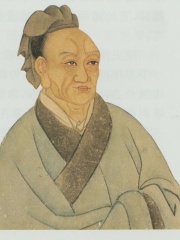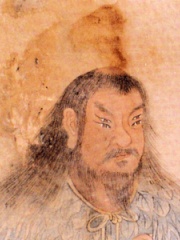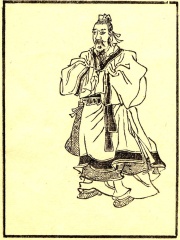


The Most Famous
HISTORIANS from China
This page contains a list of the greatest Chinese Historians. The pantheon dataset contains 339 Historians, 3 of which were born in China. This makes China the birth place of the 25th most number of Historians behind Armenia and India.
Top 3
The following people are considered by Pantheon to be the most legendary Chinese Historians of all time. This list of famous Chinese Historians is sorted by HPI (Historical Popularity Index), a metric that aggregates information on a biography’s online popularity.

1. Sima Qian (-145 - -86)
With an HPI of 77.97, Sima Qian is the most famous Chinese Historian. His biography has been translated into 111 different languages on wikipedia.
Sima Qian ([sɹ̩́mà tɕʰjɛ́n]; c. 145 – c. 86 BC) was a Chinese historian during the early Han dynasty. He is considered the father of Chinese historiography for his Records of the Grand Historian, a general history of China covering more than two thousand years beginning from the rise of the legendary Yellow Emperor and the formation of the first Chinese polity to the reign of Emperor Wu of Han, during which Sima wrote. As the first universal history of the world as it was known to the ancient Chinese, the Records of the Grand Historian served as a model for official history-writing for subsequent Chinese dynasties and the Sinosphere in general until the 20th century. Sima Qian's father, Sima Tan, first conceived of the ambitious project of writing a complete history of China, but had completed only some preparatory sketches at the time of his death. After inheriting his father's position as court historian in the imperial court, he was determined to fulfill his father's dying wish of composing and putting together this epic work of history. However, in 99 BC, he would fall victim to the Li Ling affair for speaking out in defense of the general, who was blamed for an unsuccessful campaign against the Xiongnu. Given the choice of being executed or castrated, he chose the latter in order to finish his historical work. Although he is universally remembered for the Records, surviving works indicate that he was also a gifted poet and prose writer, and he was instrumental in the creation of the Taichu calendar, which was officially promulgated in 104 BC. As his position in the imperial court was "Grand Historian" (tàishǐ 太史)—variously translated as 'court historian', 'scribe', 'astronomer', or 'astrologer'—later generations would accord him with the honorific title of "Lord Grand Historian" (Tàishǐ gōng 太史公) for his monumental work. However, his magnum opus was completed many years after his tenure as Grand Historian ended in disgrace and after his acceptance of punitive actions against him including imprisonment, castration, and subjection to servility. He was acutely aware of the importance of his work to posterity and its relationship to his own personal suffering. In the postface of the Records, he implicitly compared his universal history of China to the classics of his day, the Guoyu by Zuo Qiuming, "Li Sao" by Qu Yuan, and the Art of War by Sun Bin, pointing out that their authors all suffered great personal misfortunes before their lasting monumental works could come to fruition. Sima Qian is also depicted in the Wu Shuang Pu by Jin Guliang.

2. Cangjie (-2650 - )
With an HPI of 57.68, Cangjie is the 2nd most famous Chinese Historian. His biography has been translated into 23 different languages.
Cangjie [tsʰáŋ.tɕjě] (Chinese: 倉頡) is a legendary ancient Chinese figure said to have been an official historian of the Yellow Emperor and the inventor of Chinese characters. Legend has it that he had four eyes, and that when he invented the characters, the deities and ghosts cried and the sky rained millet. He is considered a legendary rather than historical figure, or at least not considered to be the sole inventor of Chinese characters. Cangjie was the eponym for the (c. 220 BCE) Cangjiepian proto-dictionary, the Cangjie method of inputting characters into a computer, and a Martian rock visited by the Mars rover Spirit, and named by the rover team.

3. Guo Pu (276 - 324)
With an HPI of 51.18, Guo Pu is the 3rd most famous Chinese Historian. His biography has been translated into 15 different languages.
Guo Pu (Chinese: 郭璞; AD 276–324), courtesy name Jingchun (Chinese: 景純; pinyin: Jǐngchún), was a Chinese historian, poet, and writer during the Eastern Jin period, and is best known as one of China's foremost commentators on ancient texts. Guo was a Taoist mystic, geomancer, collector of strange tales, editor of old texts, and erudite commentator. He was the first commentator of the Shan Hai Jing and so probably, with the noted Han bibliographer Liu Xin, was instrumental in preserving this valuable mythological and religious text. Guo Pu was the well educated son of a governor. He was a natural historian and a prolific writer of the Jin dynasty. He is the author of The Book of Burial, the first-ever and the most authoritative source of feng shui doctrine and the first book to address the concept of feng shui in the history of China, making Guo Pu the first person historically to define feng shui, and therefore, Guo Pu is usually called the father of feng shui in China.
Pantheon has 3 people classified as historians born between 2650 BC and 276. Of these 3, none of them are still alive today. The most famous deceased historians include Sima Qian, Cangjie, and Guo Pu. As of April 2022, 1 new historians have been added to Pantheon including Guo Pu.







